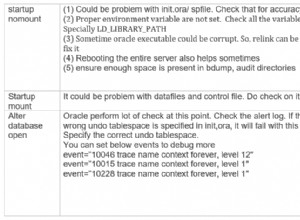Esistono diversi modi per rendere questo codice più veloce (ognuno dovrebbe essere più veloce dei precedenti, ma diventa progressivamente meno idiomatico-chiaro):
-
Esegui
insertOrUpdateAllinvece diinsertOrUpdatese su slick-pg 0.16.1+await(run(TableQuery[FooTable].insertOrUpdateAll rows)).sum -
Esegui i tuoi eventi DBIO tutti in una volta, invece di aspettare che ciascuno si impegni prima di eseguire il successivo:
val toBeInserted = rows.map { row => TableQuery[FooTable].insertOrUpdate(row) } val inOneGo = DBIO.sequence(toBeInserted) val dbioFuture = run(inOneGo) // Optionally, you can add a `.transactionally` // and / or `.withPinnedSession` here to pin all of these upserts // to the same transaction / connection // which *may* get you a little more speed: // val dbioFuture = run(inOneGo.transactionally) val rowsInserted = await(dbioFuture).sum -
Scendi al livello JDBC ed esegui il tuo upsert tutto in una volta (idea tramite questa risposta ):
val SQL = """INSERT INTO table (a,b,c) VALUES (?, ?, ?) ON DUPLICATE KEY UPDATE c=VALUES(a)+VALUES(b);""" SimpleDBIO[List[Int]] { session => val statement = session.connection.prepareStatement(SQL) rows.map { row => statement.setInt(1, row.a) statement.setInt(2, row.b) statement.setInt(3, row.c) statement.addBatch() } statement.executeBatch() }




